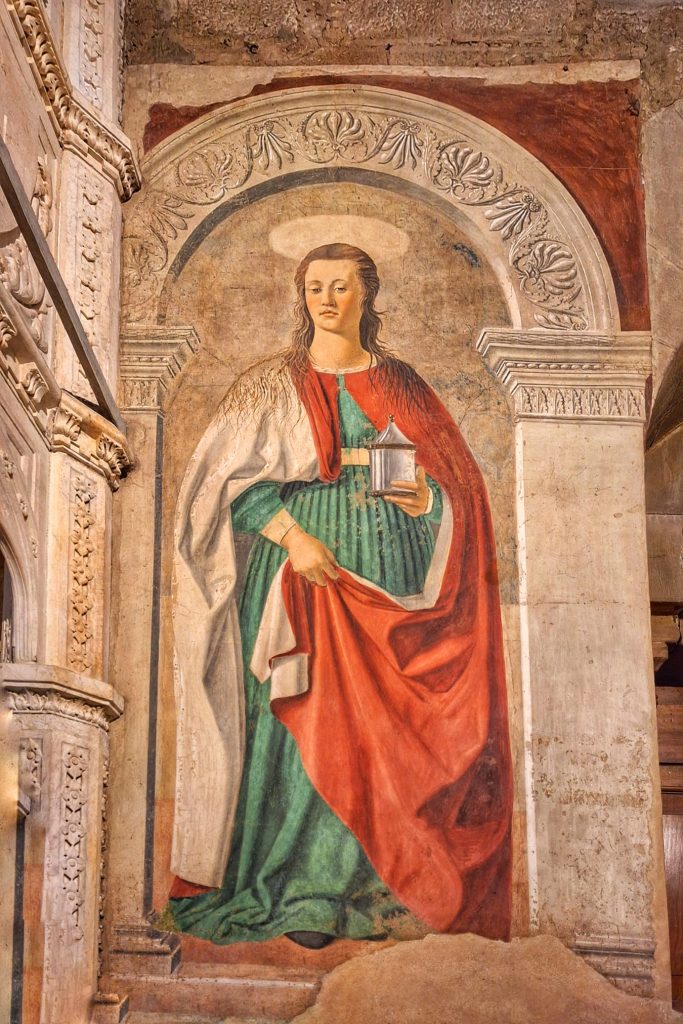Discover the “Maddalena” with Cento Passi dal Duomo
Piero della Francesca’s “Maddalena” is recognized as an irrefutable masterpiece of the Renaissance, marking a crucial phase in the artistic and cultural revolution of that era. Painted between 1459 and 1466, the fresco is positioned in a period of intense creative expression for the artist, highlighting a moment of synthesis between his investigations into perspective, the use of lighting and human portraiture.
Mary Magdalene, in italian “Maddalena”, portrayed in a state of deep reflection and spirituality, becomes an emblem of a beauty that transcends mere physical aesthetics and succeeds in reaching to the soul, demonstrating Piero’s ability to fuse technical innovations with profound sensitivity.
The rediscovery of the “Maddalena”
The rediscovery and reappraisal of the work, especially in recent years, have reaffirmed Piero della Francesca’s significance in the artistic context of the Renaissance, emphasizing his impact on generations of artists and enthusiasts.
Despite periods of obscurity during which the “Magdalene” did not receive the attention given to his other works, contemporary critics have identified it as one of the most beautiful and technically advanced female representations of the Renaissance, positioning it high in Piero’s catalog as a model of the art of the time, in which the pursuit of aesthetic perfection is combined with a new vision of the individual and his role in the world.
Location of the “Maddalena”
Installed in the left aisle of the Cathedral of San Donato in Arezzo, near the entrance to the sacristy, the fresco reveals itself to visitors in a subdued way, but reveals a deep connection with its artistic and spiritual context.
It is integrated into an environment dense with meaning and history, in which each element contributes to an ongoing dialogue between art, faith and culture, reflecting the artist’s intention to place his work in a broader context of biblical narratives and Christian tradition-as evidenced also by its thematic and stylistic proximity to the frescoes of the Legend of the True Cross.
The relationship of the “Maddalena” with the “Vera Croce”
.
The “Magdalene” fresco and the True Cross frescoes are intertwined not only physically but also conceptually and stylistically, suggesting that the “Maddalena” can be seen as a conclusion to the cycle, dialoguing with the narratives through the use of light and perspective depth.
This representation of Magdalene appears almost as an emanation of those stories, carrying the tradition and opening it to new interpretations, showing how Piero’s art, rooted in his time, manages to convey universal messages.
The Colors of the “Maddalena”
During his stay in Rome Piero acquired new stimuli on the use of light and color, which find expression in the fresco. The arch framing Mary Magdalene, adorned with plant motifs, reflects influences from Roman painting of the time, harmoniously integrated into the work. The choice of complementary colors and the skillful use of light give the work a delicate and harmonious tone, reinforcing its spiritual dimension.
Symbolism in the masterpiece
The symbolism of the cruet and other details, such as Mary Magdalene’s clothing and posture, define the character and symbolic meaning of the work, demonstrating Piero’s technical mastery and ability to overcome the technical challenges of the fresco. These elements contribute to a portrait of Mary Magdalene that goes beyond simple physical representation, offering a profound human and spiritual reading.
The depiction of Maria Maddalena
Mary Magdalene is portrayed as a complex and fascinating figure, a key witness to the fundamental events of Christianity, a symbol of redemption and divine grace. Piero captures this complexity, presenting her with spiritual dignity, transforming her into a symbol of faith and conversion. Through “Magdalene,” Piero invites meditation on the themes of sin, forgiveness and salvation, reflecting the hopes and anxieties of humanity, and building a bridge between the divine and the human through art.
All the restorations of Piero’s amazing work
The history of restorations of the “Magdalene” fresco highlights the commitment to its preservation through the centuries. Let’s begin with the first documented restoration, in the early 20th century: it marks the beginning of the protection of this work, with subsequent interventions aimed at preserving its integrity.
The last significant restoration in 1994, under the technical direction of Stefano Casciu, made it possible not only to arrest the deterioration, but also to deepen our knowledge of Piero’s painting technique, confirming his innovation in fresco painting. These restorations have revealed the expressive power and original beauty of the work, demonstrating the ongoing commitment to the protection of this artistic heritage.
The Opera Today
The rediscovery of “Magdalene” in the modern art context reflects changes in historical interpretations and cultural sensibilities, bringing the work out of the shadows and recognizing it as one of the most significant representations of the Renaissance.
Renewed interest is fueled by factors such as the spread of art-historical knowledge and the evolution of restoration techniques, as well as the growing interest in important female figures in the biblical narrative. This has led Arezzo to become a must-see destination for art and history enthusiasts, enhancing cultural heritage and rediscovering previously neglected themes and artistic figures.
The rediscovery of “Maddalena” has not only broadened understanding of Piero della Francesca’s work but also renewed interest in the Italian Renaissance, showing how art can continue to offer new interpretations and stimulate reflection centuries after its creation.

